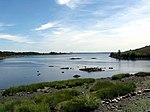Rodman's Neck

Rodman's Neck (formerly Ann Hook's Neck) refers to a peninsula of land in the New York City borough of the Bronx that juts out into Long Island Sound. The southern third of the peninsula is used as a firing range by the New York City Police Department; the remaining wooded section is part of Pelham Bay Park. The north side is joined to what used to be Hunters Island and Twin Island to form Orchard Beach and a parking lot.Rodman's Neck has three meadows. One is a natural salt water meadow; the other two are manmade freshwater meadows, one of which was created by Robert Moses' projects. The City Island Traffic Circle and several small ballfields also exist, while every original building has been razed. A landfill area for City Island Road crosses Turtle Cove Saltwater Marsh with a culvert made of concrete pipes connecting it to the salt water Eastchester Bay. A second land berm built for horsecars had its always-clogged three foot diameter culvert removed, and a trench with a stainless steel bridge was installed.
Excerpt from the Wikipedia article Rodman's Neck (License: CC BY-SA 3.0, Authors, Images).Rodman's Neck
Rodmans Neck, New York The Bronx
Geographical coordinates (GPS) Address Nearby Places Show on map
Geographical coordinates (GPS)
| Latitude | Longitude |
|---|---|
| N 40.8525 ° | E -73.800555555556 ° |
Address
Rodmans Neck
Rodmans Neck
10464 New York, The Bronx
New York, United States
Open on Google Maps









